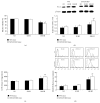Metallothionein-I/II Knockout Mice Aggravate Mitochondrial Superoxide Production and Peroxiredoxin 3 Expression in Thyroid after Excessive Iodide Exposure
- PMID: 26101557
- PMCID: PMC4458558
- DOI: 10.1155/2015/267027
Metallothionein-I/II Knockout Mice Aggravate Mitochondrial Superoxide Production and Peroxiredoxin 3 Expression in Thyroid after Excessive Iodide Exposure
Abstract
Purpose: We aim to figure out the effect of metallothioneins on iodide excess induced oxidative stress in the thyroid.
Methods: Eight-week-old MT-I/II knockout (MT-I/II KO) mice and background-matched wild-type (WT) mice were used. Mitochondrial superoxide production and peroxiredoxin (Prx) 3 expression were measured.
Results: In in vitro study, more significant increases in mitochondrial superoxide production and Prx 3 expression were detected in the MT-I/II KO groups. In in vivo study, significantly higher concentrations of urinary iodine level were detected in MT-I/II KO mice in 100 HI group. Compared to the NI group, there was no significant difference existing in serum thyroid hormones level in either groups (P > 0.05), while the mitochondrial superoxide production was significantly increased in 100 HI groups with significantly increased LDH activity and decreased relative cell viability. Compared to WT mice, more significant changes were detected in MT-I/II KO mice in 100 HI groups. No significant differences were detected between the NI group and 10 HI group in both the MT-I/II KO and WT mice groups (P > 0.05).
Conclusions: Iodide excess in a thyroid without MT I/II protection may result in strong mitochondrial oxidative stress, which further leads to the damage of thyrocytes.
Figures


Similar articles
-
Activation of the Nrf2-Keap 1 Pathway in Short-Term Iodide Excess in Thyroid in Rats.Oxid Med Cell Longev. 2017;2017:4383652. doi: 10.1155/2017/4383652. Epub 2017 Jan 4. Oxid Med Cell Longev. 2017. PMID: 28133506 Free PMC article.
-
Propylthiouracil, Perchlorate, and Thyroid-Stimulating Hormone Modulate High Concentrations of Iodide Instigated Mitochondrial Superoxide Production in the Thyroids of Metallothionein I/II Knockout Mice.Endocrinol Metab (Seoul). 2016 Mar;31(1):174-84. doi: 10.3803/EnM.2016.31.1.174. Endocrinol Metab (Seoul). 2016. PMID: 26754589 Free PMC article.
-
Effects of perinatal exposure to low doses of cadmium or methylmercury on thyroid hormone metabolism in metallothionein-deficient mouse neonates.Toxicology. 2006 Nov 10;228(1):77-84. doi: 10.1016/j.tox.2006.08.017. Epub 2006 Aug 22. Toxicology. 2006. PMID: 16982123
-
Metallothioneins I and II: neuroprotective significance during CNS pathology.Int J Biochem Cell Biol. 2007;39(3):484-9. doi: 10.1016/j.biocel.2006.09.010. Epub 2006 Oct 10. Int J Biochem Cell Biol. 2007. PMID: 17097331 Review.
-
[Analysis of toxicity using metallothionein knockout mice].Yakugaku Zasshi. 2007 Apr;127(4):709-17. doi: 10.1248/yakushi.127.709. Yakugaku Zasshi. 2007. PMID: 17409701 Review. Japanese.
Cited by
-
Activation of the Nrf2-Keap 1 Pathway in Short-Term Iodide Excess in Thyroid in Rats.Oxid Med Cell Longev. 2017;2017:4383652. doi: 10.1155/2017/4383652. Epub 2017 Jan 4. Oxid Med Cell Longev. 2017. PMID: 28133506 Free PMC article.
-
Capsiate ameliorates secondary hyperparathyroidism by improving insulin sensitivity and inhibiting angiogenesis.J Cell Mol Med. 2024 Apr;28(8):e18202. doi: 10.1111/jcmm.18202. J Cell Mol Med. 2024. PMID: 38591872 Free PMC article.
-
Mammalian Metallothionein-2A and Oxidative Stress.Int J Mol Sci. 2016 Sep 6;17(9):1483. doi: 10.3390/ijms17091483. Int J Mol Sci. 2016. PMID: 27608012 Free PMC article. Review.
-
Is beta-carotene consumption associated with thyroid hormone levels?Front Endocrinol (Lausanne). 2023 May 26;14:1089315. doi: 10.3389/fendo.2023.1089315. eCollection 2023. Front Endocrinol (Lausanne). 2023. PMID: 37305054 Free PMC article. Review.
-
Thyroid Hormones, Oxidative Stress, and Inflammation.Mediators Inflamm. 2016;2016:6757154. doi: 10.1155/2016/6757154. Epub 2016 Mar 8. Mediators Inflamm. 2016. PMID: 27051079 Free PMC article. Review.
References
-
- Corvilain B., Collyn L., van Sande J., Dumont J. E. Stimulation by iodide of H2O2 generation in thyroid slices from several species. The American Journal of Physiology—Endocrinology and Metabolism. 2000;278(4):E692–E699. - PubMed
-
- World Health Organization. WHO Booklet. World Health Organization; 1999. International Council for Control of Iodine Deficiency Disorders 1999 progress towards the elimination of iodine deficiency disorders (IDD)
Publication types
MeSH terms
Substances
LinkOut - more resources
Full Text Sources
Other Literature Sources
Research Materials

